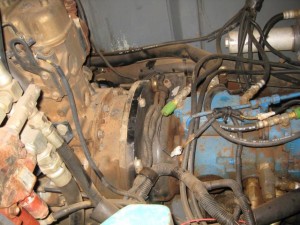How to access the battery on a bobcat
- working on the innards – diagnosing an electrical malfunction
I bought an old bobcat – actually it is a Takeuchi tracked loader but it looks and operates like a bobcat on tracks (not wheels) and since most people know what a bobcat is, I refer to it simply as a “bobcat”. At the time of purchase it was in pretty bad condition but as the seller and his team struggled to get it going I was able to learn a lot about how these things work. Since it didn’t start, the battery had to be charged and I learned that the way to get to the battery is to undo the securing bolts and pull the cab over so it leans above the bucket. I suggested to the seller that maybe it needed a new battery but the he said confidently that the battery was good and I remembered this later when again it wouldn’t start. There were other problems such as the key did not switch off the engine and you had to use a button they had wired in specially for cutting off the engine, and the instrument panel didn’t work, and it leaked etc. etc.
What to do when the battery fails
However, to get back to the battery. When the cold weather rolled in a few months later the engine wouldn’t start but it turned somewhat when I turned the key so I figured the problem was the glow plugs. Since someone had wired in a replacement ignition switch and there was no clicking sound when the switch was turned to “on” (the position before start) I bought a new switch, wired it in and the glow plugs clicked and worked and the engine started. Additionally, the new switch was able to turn off the engine when I was done, so the switching off problem was resolved and I didn’t need the crude rigged cut off button. However, the battery seemed to get weaker and weaker with use and when I stalled the bobcat in the field ( I shouldn’t have stalled it but I am still a novice and it cut out when I overloaded it) I was stuck. The reason I was stuck in the field is, though I have a generator and battery charger, I couldn’t access the battery since to get to the battery you have to roll the cab over and this was beyond my single handed efforts. In the storage building I pull the cab over regularly with a cable come along which is a hand winch cable puller. To do this you have to secure one end to the cab and the other to a fixed point – out in the field there were no fixed points and since I was on a slope bringing up the tractor or pickup would have been difficult. (With my independence and ego at stake it was obviously not acceptable to ask a neighbor to help me pull the cab over). I was able to solve this batter charging problem by removing one of the 20 amp fuses from the fuse box, inserting a nail into the clip which held the fuse (on the side which led to the battery) and attaching the positive cable from the charger to the nail and the negative cable to a clean bolt on the body. With the battery charged I started the engine and chugged back to the storage building where I could at leisure figure out the problem of the fading battery.
Is it the battery or the generator?
My thoughts went like this – the problem could be the battery but the seller said it was a good battery. So I inspected the battery and saw, from a label attached to the battery, that it had been purchased 8 months earlier . After I charged the battery again I tested it with my tester which has large clamps and applies a load and found the condition of the battery was ok. So the problem then was that the battery was not being charged. This could be because the generator was not generating power for the battery or, the generator was ok but the wiring from the generator to the battery was defective (given the overall state of the wiring of the bobcat, this was a real candidate). I then studied how this generator works – although the bobcat was built in the mid 90’s the generator it used was fitted in Japanese autos from 1968 to 1976. By applying my voltage tester to the generator output with the engine running, I determined the generator was not generating power. The problem could be the generator was defective or it wasn’t receiving instructions to generate power. I decided to take the plunge and get a new generator without establishing the one or the other, since a new (reconditioned) generator cost around $30 and the old one looked pretty shot anyhow. After installing the new generator it still didn’t work but I was able to determine that the input wires to the generator were reversed – I had assumed I could simply insert the plug bringing the input wires into the generator since the plug fitted exactly into the generator, but this was not the case, the wires were reversed. After unreversing the input wires, I tested the voltage at the battery with the engine running and it was around 14 volts and I was happy – the battery was being charged. And that was the end of the saga of the fading battery.

